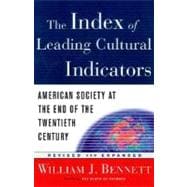
| Introduction | p. 1 |
| Crime | p. 7 |
| Total Crimes | p. 9 |
| Violent Crimes | p. 15 |
| Juvenile Violent Crime | p. 21 |
| Imprisonment | p. 26 |
| Punishment | p. 30 |
| Drug Use | p. 34 |
| Family | p. 45 |
| Out-of-Wedlock Births | p. 47 |
| Single-Parent Families | p. 57 |
| Marriage and Cohabitation | p. 63 |
| Divorce | p. 68 |
| Child Well-Being | p. 73 |
| Welfare | p. 76 |
| Abortion | p. 81 |
| Education | p. 95 |
| Performance: Third International Mathematics and Science Study (TIMSS) | p. 97 |
| Performance: National Assessment of Educational Progress (NAEP) | p. 103 |
| Performance: Scholastic Assessment Test (SAT) | p. 110 |
| Spending | p. 113 |
| Public Schools | p. 121 |
| Youth Behavior | p. 129 |
| Out-of-Wedlock Teenage Births | p. 131 |
| Teenage Abortion | p. 140 |
| Teenage Suicide | p. 144 |
| Teenage Drug and Alcohol Abuse | p. 147 |
| Popular Culture and Religion | p. 157 |
| Television | p. 159 |
| Movies | p. 164 |
| Recreation and Leisure | p. 168 |
| Church Membership | p. 173 |
| Depression | p. 177 |
| Civic Participation | p. 183 |
| Voter Turnout | p. 185 |
| Trust and Cynicism | p. 189 |
| Charitable Giving | p. 192 |
| Immigration | p. 197 |
| Military Service | p. 201 |
| International Comparisons | p. 207 |
| Decade by Decade | p. 237 |
| Note to the Reader | p. 247 |
| Sources | p. 253 |
| Table of Contents provided by Syndetics. All Rights Reserved. |
The New copy of this book will include any supplemental materials advertised. Please check the title of the book to determine if it should include any access cards, study guides, lab manuals, CDs, etc.
The Used, Rental and eBook copies of this book are not guaranteed to include any supplemental materials. Typically, only the book itself is included. This is true even if the title states it includes any access cards, study guides, lab manuals, CDs, etc.
Excerpted from The Index of Leading Cultural Indicators: American Society at the End of the 20th Century by William J. Bennett
All rights reserved by the original copyright owners. Excerpts are provided for display purposes only and may not be reproduced, reprinted or distributed without the written permission of the publisher.